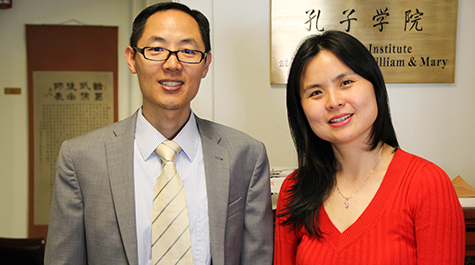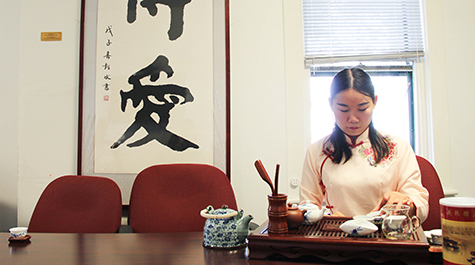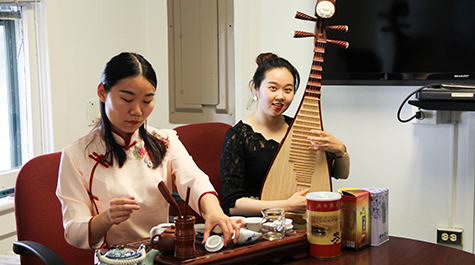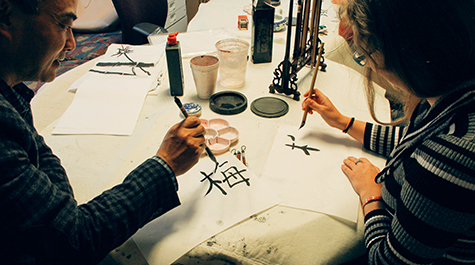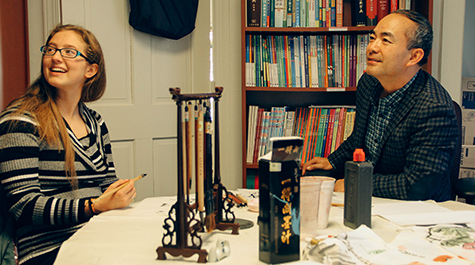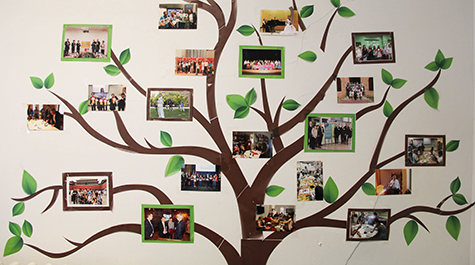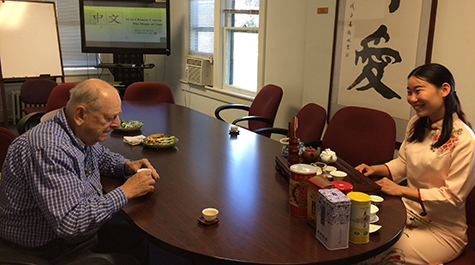WMCI’s Open House for UN Chinese Language Day Enlightens and Enchants
Language Days at the United Nations seek to celebrate multilingualism and cultural diversity. The UN celebrates six separate days, each dedicated to one of the Organization's six official languages (Spanish, English, Russian, French, Arabic and Chinese).
UN Chinese Language Day is celebrated on April 20th, a date chosen because it coincides with the commemoration in China of Cangjie, legendary historian of Huang-Di (the Yellow Emperor) and considered the inventor of Chinese characters. The official events at the UN headquarters in New York included lectures on poetry and art, and demonstrations of calligraphy and music.
The William & Mary’s Confucius Institute (WMCI) held its own Chinese Language Day event April 20th, an Open House at their headquarters in Rowe House on Jamestown Road. WMCI’s headquarters may not have the size and grandeur of the UN, but the demonstrations and displays for visitors from the university and the community, were as impressive and engaging as any that might be seen on E. 42nd street. Walking up the steps of the porch and crossing the threshold into the modest white building, it felt easy to leave Virginia behind and enter another culture and time.
WMCI offered an impressive sampling of their year-round offerings at its Open House – calligraphy, paper cutting, music and language – everything that could fit in just two small rooms, that is. Visitors could learn from the numerous photos and news clippings about the many large-scale events WMCI sponsors throughout Virginia, such as the Asian Festival at Williamsburg Pottery, the Spring Festival Celebration, and World Taiji and Qigong Day.
Educational Partnership and Outreach
Established in 2011 and dedicated in 2012, the WMCI is a collaborative educational and service partnership between William & Mary, Beijing Normal University (BNU), and the Office of Chinese Language Council International (Hanban). It aims to promote the study of Chinese language and culture, support the teaching of Chinese at both William & Mary and in the community, and facilitate US-China cultural exchanges. By sharing resources and through collaborative efforts, WMCI strives to make the learning of Chinese language and culture available to anyone who is interested in the subject, to promote multiculturalism in both the campus and the local communities, and to help construct, in a global context, a friendly and harmonious platform for international dialogues and exchanges.
Despite the small size of the office, the WMCI is robust and active all year round, sponsoring and hosting a variety of programs locally and regionally, extending beyond the Williamsburg area to Newport News (Christopher Newport University) and to the Richmond area. Their cultural demonstrations are most popular at the ChinaFest held by Richmond’s Museum of Fine Arts, an annual event that attracts more than 11,000 attendees each spring.
Educational programs for students in kindergarten through grade 12 (K-12) are also an important component of WMCI's outreach in Williamsburg. WMCI has established and developed initiatives and partnerships with local schools, Chinese culture camps, and training for teachers of Mandarin both on-site in the United States and in China.
Community Impact
There was a steady stream of visitors throughout the afternoon: residents of all ages, W&M students, faculty and staff, all curious to learn more. Some came because they had attended a course or one of the many sold-out concerts, dance performances and art exhibits. Some were there because they had seen the glorious Chinese Dragon and Giant Panda (a.k.a. good-natured and tall student intern in costume), which are perpetual favorites in the annual Homecoming Parade and local special events.
Being at William & Mary, the center of Williamsburg’s intellectual and artistic community, gives WMCI a rare opportunity to make the most of their outreach in a small but vibrant city. Deliang Wang, Ph.D., is the Chinese Director of WMCI, and recognizes what makes the William & Mary/BNU partnership so effective: “WMCI makes integrating with the university and the community a priority. Williamsburg is unique in that it is proud of its history and traditions and passionate in preserving them; but on the other hand, it is also very open-minded and inclusive of the outside world. Students and citizens are very nice to WMCI and happy to learn Chinese language and culture with the purpose of getting a better understanding of China.”
Whether WMCI-sponsored programs involve music, sports or food, they are eagerly anticipated by Williamsburg residents of all ages. “Since I started at WMCI in September 2013, there has been a significant increase in WMCI’s community involvement,” comments Associate Director Ying Liu. “To date, WMCI has established partnerships with six elementary schools and a number of local organizations such as the world-famous Williamsburg Pottery, Williamsburg Regional Library, Williamsburg United Methodist Church to offer Chinese language and culture programs.”
As if on cue, in the first room at the Open House, a Williamsburg resident, retiree Roy Snyder, is enjoying a tea ceremony led by Li Zhao, Chinese House Tutor, as Volunteer Teacher Tingting Mei plays exquisite traditional melodies on the pipa. Snyder is a frequent participant in WMCI’s community courses, especially the cooking classes. He is not alone. WMCI community courses are enthusiastically embraced and boast full enrollment. Liu confirms that, “Chinese Cooking and Chinese Painting are traditionally the most popular, though in recent years I have seen an increase in people taking Chinese language classes.”
Snyder has traveled to China and appreciates the ability to continue learning about Chinese culture – even though he asserts with a laugh that that he’s “the worst language student they’ve ever taught.” But for him and his fellow students, he finds that the most valuable impact of the WMCI in Williamsburg is that it provides an opportunity for residents to get to know visiting scholars, artists and educators from China and experts on China from around the world. “WMCI really is a bridge between the two cultures, and I so appreciate that I can ask questions and learn not only about history and art, but also discuss current events and issues.”
In WMCI’s library, Micailya Mattson ’18 is learning how to write her name in Chinese from visiting professor Guanxin Shi and volunteer teacher Kaiyan Gao. Mattson is a neuroscience major and interested in other cultures (she studied abroad in Copenhagen), but this is her first experience at the Confucius Institute, and she is clearly delighted – also demonstrates a real facility with calligraphy. “I’m a senior and realized this was an opportunity I didn’t want to miss,” she remarks, holding up her work.
There are countless books in the shelf behind Mattson and throughout the building, proof that WMCI is both cultural ambassador and resource center. And it is clear that while the activities are joyful and designed to be positive and engaging, as Wang explains most eloquently and seriously, the work of WMCI is profound and important:
“I hope WMCI will become a center for providing resources to students of William and Mary and local community members to learn Chinese language and culture; that WMCI will become a channel for mutual understandings and a bridge for establishing friendship between China and the United States.”
The William & Mary and Williamsburg communities share that hope.
 Skip to main content
Skip to main content

